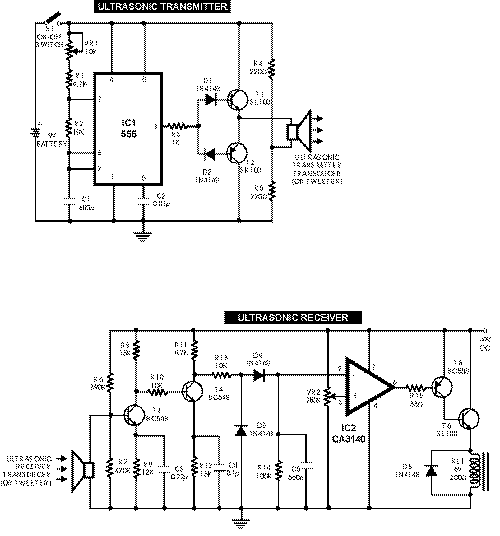Ultrasonic Switch
C ircuit of a new type of remote control switch is described here. This
circuit functions with inaudible (ultrasonic) sound. Sound of frequency up to 20
kHz is audible to human beings. The sound of frequency above 20 kHz is called
ultrasonic sound. The circuit described generates (transmits) ultrasonic sound
of frequency between 40 and 50 kHz. As with any other remote control system this
cirucit too comprises a mini transmitter and a receiver circuit. Transmitter
generates ultrasonic sound and the receiver senses ultrasonic sound from the
transmitter and switches on a relay. The ultrasonic transmitter uses a 555 based
astable multivibrator. It oscillates at a frequency of 40-50 kHz. An ultrasonic
transmitter transducer is used here to transmit ultrasonic sound very
effectively. The transmitter is powered from a 9-volt PP3 single cell. The
ultrasonic receiver circuit uses an ultrasonic receiver transducer to sense
ultrasonic signals. It also uses a two-stage amplifier, a rectifier stage, and
an operational amplifier in inverting mode. Output of op-amp is connected to a
relay through a complimentary relay driver stage. A 9-volt battery eliminator
can be used for receiver circuit, if required. When switch S1 of transmitter is
pressed, it generates ultrasonic sound. The sound is received by ultrasonic
receiver transducer. It converts it to electrical variations of the same
frequency. These signals are amplified by transistors T3 and T4. The amplified
signals are then rectified and filtered. The filtered DC voltage is given to
inverting pin of op-amp IC2. The non- inverting pin of IC2 is connected to a
variable DC voltage via preset VR2 which determines the threshold value of
ultrasonic signal received by receiver for operation of relay RL1. The inverted
output of IC2 is used to bias transistor T5. When transistor T5 conducts, it
supplies base bias to transistor T6. When transistor T6 conducts, it actuates
the relay. The relay can be used to control any electrical or electronic
equipment. Important hints:
1. Frequency of ultrasonic sound generated can be varied from 40 to 50 kHz range
by adjusting VR1. Adjust it for maximum performance.
2. Ultrasonic sounds are highly directional. So when you are operating the
switch the ultrasonic transmitter transducer of transmitter should be placed
towards ultrasonic receiver transducer of receiver circuit for proper
functioning.
3. Use a 9-volt PP3 battery for transmitter. The receiver can be powered from a
battery eliminator and is always kept in switched on position.
4. For latch facility use a DPDT relay if you want to switch on and switch off
the load. A flip-flop can be inserted between IC2 and relay. If you want only an
СON-time delayТ use a 555 only at output of IC2. The relay will be energised for
the required period determined by the timing components of 555 monostable
multivibrator.
5. Ultrasonic waves are emitted by many natural sources. Therefore, sometimes,
the circuit might get falsely triggered, espically when a flip-flop is used with
the circuit, and there is no remedy for that.
Title: Ultrasonic Switch
electronic circuit
Source: www.electronic-circuits-diagrams.com
Published on: 2005-02-01
Reads: 1654
Print version: ![]()
Other electronic circuits and schematics from Audio
-
Minimalist Discrete Hi-Fi Preamp
-
20W Power Amplifier
-
100W RMS Amplifier
-
Baxendall Tone Control
-
Audio Visual Indicator for Telephones
-
250 mW Audio Amplifier
-
Stereo Tube Amplifier
-
Sound Controlled Filp Flop
-
Portable Microphone Preamplifier
-
Speech Recorder

